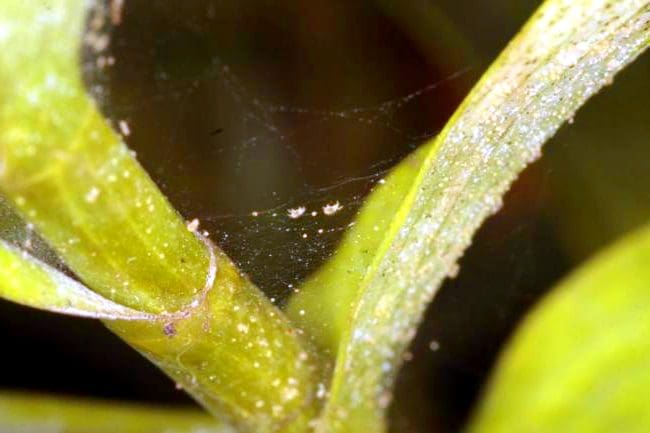
To a spider mite, the leaf of a medium-size houseplant must seem as vast as the state of California. These eight-legged critters—cousins of ordinary spiders and sometimes called red spiders-measure only about 1/50 of an inch long, so don’t expect to get a good look at one without the help of a strong magnifying glass. In good light, though, you can see colonies with your naked eye. Look at the undersides of leaves, especially along the veins and edges where mites like to congregate; a bronze or reddish hue means they’re at work sucking away your plant’s vital juices.
Symptoms:
Whitish or yellowish speckled spots on the tops of leaves are your first clue that spider mites have arrived. Eventually, leaves take on a bronze or yellow look and may die or drop off. Silky webbing, like the frail strands at left, means your plant has a bad case.
Life cycle:
Spider mites begin life as eggs and live for about a month. During that time, the number of eggs one of these characters can lay depends largely upon temperature. At 60 degrees, one female will produce only about 20 eggs-not a big family in the mite world. Increase the temperature to 80 degrees and her tribe could potentially reach 13 million! The eggs like it hot, too. At 80 degrees, they’ll hatch in about five days-at 60 degrees, almost 15 days. Seven days is typical. This explains why spider mites seem to go wild in warm locations or during those first hot days of spring or summer. They thrive in dry environments, too.
As populations explode, mite-gration begins. Young females glide on their silky threads to other leaves-or ride air currents, clothes, or your hands to other plants. Some even set out on foot.
Controls:
Since cooler temperatures and higher humidity levels greatly inhibit mites, try to provide these conditions for susceptible plants.
Periodically check all plants for spider mites, as explained above. Be especially vigilant during warm periods. And if you happen to take your plant outdoors, check it carefully before you bring it in. Isolate it from your other plants for a week or two, then check again. Spider mites abound in outside vegetation.
If you spot evidence of mites, isolate the plant immediately and bathe it weekly with mildly soapy water. Be sure to wash away any webbing and give the undersides of leaves a good scrubbing. This will remove all or most of the adults, but it won’t affect the eggs. To get these, you have to wait a week until they hatch, then wash again. Repeat once more a week later.
